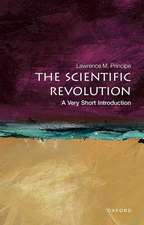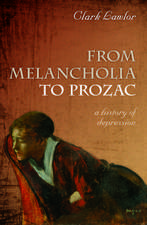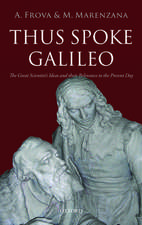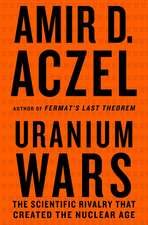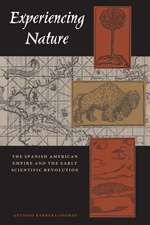The Day We Found the Universe
Autor Marcia Bartusiaken Limba Engleză Paperback – 28 feb 2010
Vezi toate premiile Carte premiată
L.A. Times Book Prize (2009)
On New Years Day in 1925, a young Edwin Hubble released his finding that our Universe was far bigger, eventually measured as a thousand trillion times larger than previously believed. Hubble’s proclamation sent shock waves through the scientific community. Six years later, in a series of meetings at Mount Wilson Observatory, Hubble and others convinced Albert Einstein that the Universe was not static but in fact expanding. Here Marcia Bartusiak reveals the key players, battles of will, clever insights, incredible technology, ground-breaking research, and wrong turns made by the early investigators of the heavens as they raced to uncover what many consider one of most significant discoveries in scientific history.
Preț: 126.36 lei
Nou
Puncte Express: 190
Preț estimativ în valută:
24.18€ • 25.15$ • 19.96£
24.18€ • 25.15$ • 19.96£
Carte disponibilă
Livrare economică 24 martie-07 aprilie
Preluare comenzi: 021 569.72.76
Specificații
ISBN-13: 9780307276605
ISBN-10: 0307276600
Pagini: 337
Ilustrații: 57
Dimensiuni: 138 x 203 x 20 mm
Greutate: 0.33 kg
Editura: Vintage Books USA
ISBN-10: 0307276600
Pagini: 337
Ilustrații: 57
Dimensiuni: 138 x 203 x 20 mm
Greutate: 0.33 kg
Editura: Vintage Books USA
Notă biografică
Marcia Bartusiak is an award-winning author whose previous books include Through a Universe Darkly, Thursday’s Universe, Einstein’s Unfinished Symphony, and Archives of the Universe. Her work has appeared in such publications as National Geographic, Smithsonian, Discover, The New York Times, and The Washington Post. She teaches at MIT and lives in Sudbury, Massachusetts
Extras
[1]
The Little Republic of Science
An immense continent of rock known as the North American plate slid inexorably over an oceanic slab of Earth’s crust moving eastward. At the tectonic juncture, where the two gargantuan plates smashed together, the ocean floor plunged downward, the tremendous compression forging massive blocks of shale and sandstone. In due course some of this material lifted upward from its depths, relentlessly rising toward the sky to form the Diablo Mountain Range—two hundred miles of peaks and vales stretching from the San Francisco Bay southward along California’s coastline. As if readying for a performance, nature sculpted the landscape that, millions of years later, offered astronomers a unique observing platform for their studies of the cosmos. Situated on the eastern edge of the Pacific, this lofty terrain became the perfect vantage point from which to make the first great discoveries in twentieth-century astronomy.
One noticeable peak in the Diablo Range, some forty miles from the sea, was known to early settlers as La Sierra de Ysabel. The first to record an ascent to its uppermost reaches were William Brewer, a geologist who worked on California’s first complete geological survey, and Charles Hoffman, a topographer. Laurentine Hamilton, then a Presbyterian minister from San Jose, tagged along for the 1861 summertime adventure. While journeying over the lower elevations the men used mules but struggled over the last three miles on foot. With the two scientists burdened down by their heavy equipment, the minister was able to sprint ahead, pushing through the chaparral, mesquite, and thick groves of scrub oak that filled the mountain’s furrowed sides like well-sprinkled seasoning. Upon reaching the summit, Hamilton waved his hat in the air and exclaimed, “First on top, for this is the highest point.” In honor of the achievement, Brewer graciously named the peak after his “noble and true” friend.
Within three decades Mount Hamilton was the site of a radical new endeavor in astronomy. Fueled by America’s escalating wealth, “the public mind in this country is now directed to the importance of original scientific research,” wrote Joseph Henry, head of the Smithsonian Institution, in 1874 to the noted English biologist Thomas Huxley, “and I think there is good reason to believe that some of the millionaires who have risen from poverty to wealth will in due time seek to perpetuate their names by founding establishments for the purpose in question.” In the vanguard to answer that call was San Francisco entrepreneur James Lick, who funded the world’s first astronomical observatory permanently established at high elevation. Before this, professional telescopes were routinely constructed in relatively low-lying areas, near major cities or on university campuses for easy access.
In 1888, from its commanding perch atop Mount Hamilton, the Lick Observatory began operating the largest telescope in its day, which featured a pair of imposing lenses a full yard wide to gather and magnify the celestial light. It was the same type of telescope through which Galileo first peered, one that directed the light through two aligned pieces of glass, but the diameter of the Lick instrument was a couple of dozen times larger. Its founder spared no expense to house this giant refractor. The massive building was designed in a classical style by Washington architect S. E. Todd. From afar, it appeared as if a European palace had been magically transported to the American West. Inside its dome, hand-carved moldings decorated the walls. The floors were curved wooden planks, polished to a sheen and stylishly following the shape of the circular dome. Tourists traveled on stagecoach for hours for a glimpse of this new wonder of the scientific world.
Unbeknownst to those visitors, though, the most innovative work at Lick was actually being done in more modest surroundings, about a quarter of a mile south of the showstopping telescope, at the end of a mountain spur known as Ptolemy Ridge. There, in a far smaller dome that resembles a quaint medieval chapel, James Keeler labored to put a reflecting telescope into operation, which used a silvered mirror instead of a lens to magnify its image. It was an instrument that everyone warned him would be nothing but trouble. Big-lensed refractors were the telescopes of choice in the late 1800s, but Keeler bravely broke from that tradition, establishing an approach in professional astronomy that eventually spread to every major observatory throughout the world.
Though now reduced to a minor figure in many histories of astronomy, Keeler was actually a forerunner to the birth of modern cosmology, a crucial player in helping launch the new field. A man who could manipulate a spectroscope like no other, he pioneered uses for the new instrument at a time when astronomers were just beginning to apply the methods of physics in their work. This specialty, newly tagged “astrophysics,” enabled observers at last to discern the chemical and physical natures of stars, planets, and nebulae.
In Keeler’s time the universe was a far simpler place, at least to our modern-day eyes. The cosmos consisted solely of a vast collection of stars, a disk-shaped distribution somewhat flattened, with the Sun situated in an honored place near the center. Beyond that, said most astronomers, was simply a void—possibly extending out to infinity.
But there were oddities in the celestial sky, difficult to explain. There were these mysterious nebulae that through a telescope looked like watery whirlpools, mistlike clouds exhibiting spiraling shapes. Astronomers were long acquainted with other types of nebulae, such as the vast and chaotic cloud in Orion and the ringlike nebulae, but these vaporous objects resided within the bounds of the Milky Way. The spiral nebulae, on the other hand, were solely found away from the milky band of our galaxy. Why did they prefer the more open cosmic spaces, as if they were avoiding the stars? Astronomers didn’t have a good, rational explanation for this unique distribution. Keeler, to his credit, made these nebulae his prime subject for investigation, at a time when the study of stars and planets was far more attractive to astronomers. Before the introduction of photography, the number of nebulous clouds in the heavens was estimated to be in the thousands. Mounting a camera onto his reflecting telescope, Keeler began to realize there were likely tens of thousands. His discovery was a revelation, and in making this masterful leap in observing, Keeler opened up a vast new arena for astronomy.
Keeler’s celestial curiosity may have initially been sparked by a dramatic solar eclipse he witnessed in 1869 when he was eleven—its narrow path of totality creating a sensation as the Moon’s shadow stretched across the United States. A few months later, his family moved from Illinois to Mayport, Florida, where Keeler was homeschooled, surrounded by the stacks of Scientific Americans to which his father subscribed. Ordering some lenses from an optical dealer who advertised in the magazine, young Keeler built his first telescope—a 21⁄2-inch refractor with a cedar tube. He was soon spending long nights at his scope drawing sketches of lunar craters and the planets. He was riding the wave of a new American fancy.
Earlier in the nineteenth century astronomical research in the United States had been a rather haphazard affair, until two key events dramatically altered the situation. In the autumn of 1833 people throughout the country witnessed a meteor storm, torrents of shooting stars, like no other. It was described as a “constant succession of fire balls, resembling sky rockets, radiating in all directions from a point in the heavens,” which led to this spectacular celestial fireworks show being called the “Falling of the Stars.” A decade later the public went agog once again over the Great Comet of 1843, proclaimed by Yale astronomer Denison Olmsted in that preelectric era as “the most remarkable in its appearance of all that have been seen in modern times.” The comet was visible even in daylight, with a nucleus as bright as the full Moon and a tail that stretched for nearly two million miles. Together, the meteor blizzard and the comet sparked a huge surge of public interest in the heavens. It also made U.S. politicians woefully aware of their country’s lack of first-rate scientific institutions to study such captivating phenomena. The English novelist Frances Trollope, who spent some time in America in the 1820s, had found it “extraordinary that a people who loudly declare their respect for science, should be entirely without observatories. Neither at their seats of learning, nor in their cities, does anything of the kind exist.”
This deficiency was quickly remedied with the opening of observatories in both Cincinnati, Ohio, and Chapel Hill, North Carolina, and at colleges such as Yale, Harvard, and Williams. The U.S. Naval Observatory, the country’s first national observatory, also obtained its first decent telescope. During this period before the Civil War, additional observatories quickly sprang up, becoming the scientific facility de rigueur for major American cities and colleges. These efforts at last fulfilled the vision of John Quincy Adams, America’s sixth president, who had long pushed for the country to erect a “lighthouse in the sky.” “Some Americans, haunted by a nagging sense of cultural inferiority and smarting from invidious comparisons with Europe, fostered astronomical research as a matter of national pride,” writes historian Howard Miller. And once in place, these pioneering astronomical outposts stimulated a continuing interest, especially among young boys like Keeler who dreamed of one day taking part in this new American endeavor.
Described by acquaintances as a “lankey green country boy” with a backwoods “cracker drawl,” Keeler came to develop special skills in building instruments, which enabled him to enter Johns Hopkins, America’s first research university, just a year after the institution opened in Baltimore, Maryland. Upon graduation in 1881, Keeler began work near Pittsburgh at the Allegheny Observatory, headed up by Samuel P. Langley, the man who two decades later would almost beat the Wright brothers at getting a piloted, self-propelled aircraft flying. A year of graduate work in Germany in 1883–84 sharpened Keeler’s expertise in spectral analysis. All this preparation turned out to be indispensable when he received an offer to join the staff of the Lick Observatory, the revolutionary new mecca for astronomy in central California.
James Lick initiated a remarkable trend. He stood at the head of a long line of prosperous benefactors in the late nineteenth and early twentieth centuries who used the business fortunes they accrued in the United States to construct some of the most productive observatories in astronomical history. Given his largesse, Lick raised the stakes in astronomy. Before this, the most acclaimed observatories were in Europe and sponsored by either universities or governments. With resources sparse, these institutions were often slow to adopt new techniques and instruments. At each observatory, surveys plugged along for decades, often using just one key telescope. But the Lick Observatory offered a new model for research, one that ran at a quicker pace enriched by private capital. Lick made big telescopes the commemorative monument of choice among the American nouveaux riches. Moreover, with these privately funded observatories being established from scratch, they were able to purchase the finest instruments and adopt the latest technologies. As a consequence, astronomy advanced in the United States at a faster pace than in any other country in the history of science. “Starting from essentially zero at the beginning of the nineteenth century,” says historian Stephen Brush, “the Americans had overtaken the Germans to jump into second place by the end of that century and were already challenging the British for the top spot.” Domination of the heavens appeared to go hand in hand with economic riches.
Lick earned his riches. Born in 1796 to a rural Pennsylvania Dutch family, just as the new republic of the United States was getting under way, he learned the trade of woodworking at the side of his father. After making a fairly comfortable living running his own shop in New York City, Lick abruptly decided in 1821 to move to South America, bent on amassing a fortune. There he became a master builder of fine-wood piano cases, a venture that proved highly lucrative in a culture where dancing and music were greatly valued. After twenty-seven years, though, living at first in Argentina, then Chile, and finally Peru, he decided to sell his varied business concerns and return to the United States. Arriving in San Francisco by ship in 1848, just as California was about to secede from Mexico, he came ashore with $30,000 in gold doubloons and six hundred pounds of Peruvian chocolate made by his friend Domingo Ghirardelli.
Wasting no time, Lick quickly put his incisive business acumen to work. He shrewdly used his gold to purchase real estate in San Francisco, then just a scrubby town with scarcely a thousand inhabitants. When residents started heading to the hills to make their fortune in the California gold rush, Lick was there to provide them with a stake by buying up their town land at bargain prices. He also bought a gristmill, greatly expanding it, and built California’s first great luxury hotel, the opulent Lick House, which occupied an entire city block (and was later destroyed in the fire that tore through San Francisco after its horrific 1906 earthquake).
Lick never married but still built a homestead at the south end of San Jose, where he lovingly cultivated rare plants and shrubs from around the world. The community considered him an eccentric miser; he dressed like a tramp and at times slept on a bare mattress laid out atop a piano crate. As a youth, he had gotten a girl pregnant, but her father, a prosperous miller, refused his offer to marry her, judging Lick too poor and socially inferior. The miller could hardly have imagined how astronomy, decades later, would benefit from this snobbish rebuff. Without a legitimate heir, Lick, in his old age, began to think of using some of his tremendous wealth (he had accumulated nearly $4 million, around $100 million in today’s dollars) to erect a gargantuan monument to himself. For Lick it was a chance at immortality. He particularly favored the idea of constructing a giant marble pyramid on the corner of Fourth and Market streets in downtown San Francisco, a structure that would have surpassed Egypt’s Great Pyramid of Giza in size.
But a few auspicious encounters revised this vainglorious plan. Lick had once spent a few days with a visiting amateur astronomer and lecturer, George Madeira, who captivated him with talks about astronomy’s latest discoveries. They met again a few years later for some telescope viewing when Madeira allegedly asserted, “If I had your wealth, Mr. Lick, I would construct the largest telescope possible to construct.” Around the same time Joseph Henry, then head of the National Academy of Sciences as well as the Smithsonian, was visiting San Francisco and arranged a meeting with Lick to discuss how wealthy men could use their money to cultivate science. The following year, 1872, the Harvard naturalist Louis Agassiz gave a widely reported lecture at the California Academy of Sciences, where Agassiz echoed Henry’s refrain.
All these lessons struck a chord. Lick soon astonished the California Academy when he granted the institute, without prior notice, the gift of a downtown lot to build a museum and more expansive headquarters. Academy president George Davidson, a geodetic surveyor and astronomer, promptly called on Lick to thank him, initiating a friendship. When Lick was later felled by a stroke and confined to a two-room suite at his hotel for nearly a year, Davidson regularly visited, engaging Lick with chats about the rings of Saturn, the belts of Jupiter, and other astronomical topics. Lick soon abandoned his scheme to build a pyramid and decided instead to erect a telescope “superior to and more powerful than any telescope yet made,” right on his favored city spot, the corner of Fourth and Market.
The Little Republic of Science
An immense continent of rock known as the North American plate slid inexorably over an oceanic slab of Earth’s crust moving eastward. At the tectonic juncture, where the two gargantuan plates smashed together, the ocean floor plunged downward, the tremendous compression forging massive blocks of shale and sandstone. In due course some of this material lifted upward from its depths, relentlessly rising toward the sky to form the Diablo Mountain Range—two hundred miles of peaks and vales stretching from the San Francisco Bay southward along California’s coastline. As if readying for a performance, nature sculpted the landscape that, millions of years later, offered astronomers a unique observing platform for their studies of the cosmos. Situated on the eastern edge of the Pacific, this lofty terrain became the perfect vantage point from which to make the first great discoveries in twentieth-century astronomy.
One noticeable peak in the Diablo Range, some forty miles from the sea, was known to early settlers as La Sierra de Ysabel. The first to record an ascent to its uppermost reaches were William Brewer, a geologist who worked on California’s first complete geological survey, and Charles Hoffman, a topographer. Laurentine Hamilton, then a Presbyterian minister from San Jose, tagged along for the 1861 summertime adventure. While journeying over the lower elevations the men used mules but struggled over the last three miles on foot. With the two scientists burdened down by their heavy equipment, the minister was able to sprint ahead, pushing through the chaparral, mesquite, and thick groves of scrub oak that filled the mountain’s furrowed sides like well-sprinkled seasoning. Upon reaching the summit, Hamilton waved his hat in the air and exclaimed, “First on top, for this is the highest point.” In honor of the achievement, Brewer graciously named the peak after his “noble and true” friend.
Within three decades Mount Hamilton was the site of a radical new endeavor in astronomy. Fueled by America’s escalating wealth, “the public mind in this country is now directed to the importance of original scientific research,” wrote Joseph Henry, head of the Smithsonian Institution, in 1874 to the noted English biologist Thomas Huxley, “and I think there is good reason to believe that some of the millionaires who have risen from poverty to wealth will in due time seek to perpetuate their names by founding establishments for the purpose in question.” In the vanguard to answer that call was San Francisco entrepreneur James Lick, who funded the world’s first astronomical observatory permanently established at high elevation. Before this, professional telescopes were routinely constructed in relatively low-lying areas, near major cities or on university campuses for easy access.
In 1888, from its commanding perch atop Mount Hamilton, the Lick Observatory began operating the largest telescope in its day, which featured a pair of imposing lenses a full yard wide to gather and magnify the celestial light. It was the same type of telescope through which Galileo first peered, one that directed the light through two aligned pieces of glass, but the diameter of the Lick instrument was a couple of dozen times larger. Its founder spared no expense to house this giant refractor. The massive building was designed in a classical style by Washington architect S. E. Todd. From afar, it appeared as if a European palace had been magically transported to the American West. Inside its dome, hand-carved moldings decorated the walls. The floors were curved wooden planks, polished to a sheen and stylishly following the shape of the circular dome. Tourists traveled on stagecoach for hours for a glimpse of this new wonder of the scientific world.
Unbeknownst to those visitors, though, the most innovative work at Lick was actually being done in more modest surroundings, about a quarter of a mile south of the showstopping telescope, at the end of a mountain spur known as Ptolemy Ridge. There, in a far smaller dome that resembles a quaint medieval chapel, James Keeler labored to put a reflecting telescope into operation, which used a silvered mirror instead of a lens to magnify its image. It was an instrument that everyone warned him would be nothing but trouble. Big-lensed refractors were the telescopes of choice in the late 1800s, but Keeler bravely broke from that tradition, establishing an approach in professional astronomy that eventually spread to every major observatory throughout the world.
Though now reduced to a minor figure in many histories of astronomy, Keeler was actually a forerunner to the birth of modern cosmology, a crucial player in helping launch the new field. A man who could manipulate a spectroscope like no other, he pioneered uses for the new instrument at a time when astronomers were just beginning to apply the methods of physics in their work. This specialty, newly tagged “astrophysics,” enabled observers at last to discern the chemical and physical natures of stars, planets, and nebulae.
In Keeler’s time the universe was a far simpler place, at least to our modern-day eyes. The cosmos consisted solely of a vast collection of stars, a disk-shaped distribution somewhat flattened, with the Sun situated in an honored place near the center. Beyond that, said most astronomers, was simply a void—possibly extending out to infinity.
But there were oddities in the celestial sky, difficult to explain. There were these mysterious nebulae that through a telescope looked like watery whirlpools, mistlike clouds exhibiting spiraling shapes. Astronomers were long acquainted with other types of nebulae, such as the vast and chaotic cloud in Orion and the ringlike nebulae, but these vaporous objects resided within the bounds of the Milky Way. The spiral nebulae, on the other hand, were solely found away from the milky band of our galaxy. Why did they prefer the more open cosmic spaces, as if they were avoiding the stars? Astronomers didn’t have a good, rational explanation for this unique distribution. Keeler, to his credit, made these nebulae his prime subject for investigation, at a time when the study of stars and planets was far more attractive to astronomers. Before the introduction of photography, the number of nebulous clouds in the heavens was estimated to be in the thousands. Mounting a camera onto his reflecting telescope, Keeler began to realize there were likely tens of thousands. His discovery was a revelation, and in making this masterful leap in observing, Keeler opened up a vast new arena for astronomy.
Keeler’s celestial curiosity may have initially been sparked by a dramatic solar eclipse he witnessed in 1869 when he was eleven—its narrow path of totality creating a sensation as the Moon’s shadow stretched across the United States. A few months later, his family moved from Illinois to Mayport, Florida, where Keeler was homeschooled, surrounded by the stacks of Scientific Americans to which his father subscribed. Ordering some lenses from an optical dealer who advertised in the magazine, young Keeler built his first telescope—a 21⁄2-inch refractor with a cedar tube. He was soon spending long nights at his scope drawing sketches of lunar craters and the planets. He was riding the wave of a new American fancy.
Earlier in the nineteenth century astronomical research in the United States had been a rather haphazard affair, until two key events dramatically altered the situation. In the autumn of 1833 people throughout the country witnessed a meteor storm, torrents of shooting stars, like no other. It was described as a “constant succession of fire balls, resembling sky rockets, radiating in all directions from a point in the heavens,” which led to this spectacular celestial fireworks show being called the “Falling of the Stars.” A decade later the public went agog once again over the Great Comet of 1843, proclaimed by Yale astronomer Denison Olmsted in that preelectric era as “the most remarkable in its appearance of all that have been seen in modern times.” The comet was visible even in daylight, with a nucleus as bright as the full Moon and a tail that stretched for nearly two million miles. Together, the meteor blizzard and the comet sparked a huge surge of public interest in the heavens. It also made U.S. politicians woefully aware of their country’s lack of first-rate scientific institutions to study such captivating phenomena. The English novelist Frances Trollope, who spent some time in America in the 1820s, had found it “extraordinary that a people who loudly declare their respect for science, should be entirely without observatories. Neither at their seats of learning, nor in their cities, does anything of the kind exist.”
This deficiency was quickly remedied with the opening of observatories in both Cincinnati, Ohio, and Chapel Hill, North Carolina, and at colleges such as Yale, Harvard, and Williams. The U.S. Naval Observatory, the country’s first national observatory, also obtained its first decent telescope. During this period before the Civil War, additional observatories quickly sprang up, becoming the scientific facility de rigueur for major American cities and colleges. These efforts at last fulfilled the vision of John Quincy Adams, America’s sixth president, who had long pushed for the country to erect a “lighthouse in the sky.” “Some Americans, haunted by a nagging sense of cultural inferiority and smarting from invidious comparisons with Europe, fostered astronomical research as a matter of national pride,” writes historian Howard Miller. And once in place, these pioneering astronomical outposts stimulated a continuing interest, especially among young boys like Keeler who dreamed of one day taking part in this new American endeavor.
Described by acquaintances as a “lankey green country boy” with a backwoods “cracker drawl,” Keeler came to develop special skills in building instruments, which enabled him to enter Johns Hopkins, America’s first research university, just a year after the institution opened in Baltimore, Maryland. Upon graduation in 1881, Keeler began work near Pittsburgh at the Allegheny Observatory, headed up by Samuel P. Langley, the man who two decades later would almost beat the Wright brothers at getting a piloted, self-propelled aircraft flying. A year of graduate work in Germany in 1883–84 sharpened Keeler’s expertise in spectral analysis. All this preparation turned out to be indispensable when he received an offer to join the staff of the Lick Observatory, the revolutionary new mecca for astronomy in central California.
James Lick initiated a remarkable trend. He stood at the head of a long line of prosperous benefactors in the late nineteenth and early twentieth centuries who used the business fortunes they accrued in the United States to construct some of the most productive observatories in astronomical history. Given his largesse, Lick raised the stakes in astronomy. Before this, the most acclaimed observatories were in Europe and sponsored by either universities or governments. With resources sparse, these institutions were often slow to adopt new techniques and instruments. At each observatory, surveys plugged along for decades, often using just one key telescope. But the Lick Observatory offered a new model for research, one that ran at a quicker pace enriched by private capital. Lick made big telescopes the commemorative monument of choice among the American nouveaux riches. Moreover, with these privately funded observatories being established from scratch, they were able to purchase the finest instruments and adopt the latest technologies. As a consequence, astronomy advanced in the United States at a faster pace than in any other country in the history of science. “Starting from essentially zero at the beginning of the nineteenth century,” says historian Stephen Brush, “the Americans had overtaken the Germans to jump into second place by the end of that century and were already challenging the British for the top spot.” Domination of the heavens appeared to go hand in hand with economic riches.
Lick earned his riches. Born in 1796 to a rural Pennsylvania Dutch family, just as the new republic of the United States was getting under way, he learned the trade of woodworking at the side of his father. After making a fairly comfortable living running his own shop in New York City, Lick abruptly decided in 1821 to move to South America, bent on amassing a fortune. There he became a master builder of fine-wood piano cases, a venture that proved highly lucrative in a culture where dancing and music were greatly valued. After twenty-seven years, though, living at first in Argentina, then Chile, and finally Peru, he decided to sell his varied business concerns and return to the United States. Arriving in San Francisco by ship in 1848, just as California was about to secede from Mexico, he came ashore with $30,000 in gold doubloons and six hundred pounds of Peruvian chocolate made by his friend Domingo Ghirardelli.
Wasting no time, Lick quickly put his incisive business acumen to work. He shrewdly used his gold to purchase real estate in San Francisco, then just a scrubby town with scarcely a thousand inhabitants. When residents started heading to the hills to make their fortune in the California gold rush, Lick was there to provide them with a stake by buying up their town land at bargain prices. He also bought a gristmill, greatly expanding it, and built California’s first great luxury hotel, the opulent Lick House, which occupied an entire city block (and was later destroyed in the fire that tore through San Francisco after its horrific 1906 earthquake).
Lick never married but still built a homestead at the south end of San Jose, where he lovingly cultivated rare plants and shrubs from around the world. The community considered him an eccentric miser; he dressed like a tramp and at times slept on a bare mattress laid out atop a piano crate. As a youth, he had gotten a girl pregnant, but her father, a prosperous miller, refused his offer to marry her, judging Lick too poor and socially inferior. The miller could hardly have imagined how astronomy, decades later, would benefit from this snobbish rebuff. Without a legitimate heir, Lick, in his old age, began to think of using some of his tremendous wealth (he had accumulated nearly $4 million, around $100 million in today’s dollars) to erect a gargantuan monument to himself. For Lick it was a chance at immortality. He particularly favored the idea of constructing a giant marble pyramid on the corner of Fourth and Market streets in downtown San Francisco, a structure that would have surpassed Egypt’s Great Pyramid of Giza in size.
But a few auspicious encounters revised this vainglorious plan. Lick had once spent a few days with a visiting amateur astronomer and lecturer, George Madeira, who captivated him with talks about astronomy’s latest discoveries. They met again a few years later for some telescope viewing when Madeira allegedly asserted, “If I had your wealth, Mr. Lick, I would construct the largest telescope possible to construct.” Around the same time Joseph Henry, then head of the National Academy of Sciences as well as the Smithsonian, was visiting San Francisco and arranged a meeting with Lick to discuss how wealthy men could use their money to cultivate science. The following year, 1872, the Harvard naturalist Louis Agassiz gave a widely reported lecture at the California Academy of Sciences, where Agassiz echoed Henry’s refrain.
All these lessons struck a chord. Lick soon astonished the California Academy when he granted the institute, without prior notice, the gift of a downtown lot to build a museum and more expansive headquarters. Academy president George Davidson, a geodetic surveyor and astronomer, promptly called on Lick to thank him, initiating a friendship. When Lick was later felled by a stroke and confined to a two-room suite at his hotel for nearly a year, Davidson regularly visited, engaging Lick with chats about the rings of Saturn, the belts of Jupiter, and other astronomical topics. Lick soon abandoned his scheme to build a pyramid and decided instead to erect a telescope “superior to and more powerful than any telescope yet made,” right on his favored city spot, the corner of Fourth and Market.
Recenzii
“With her trademark mix of meticulous research and vibrant prose, Bartusiak weaves these discoveries into a narrative equal to the excitement of that convulsive decade.” —Seed Magazine
"Bartusiak's intelligent and engaging book may well become the standard popular account."--Washington Post
"Fascinating." —The Boston Globe
"A science writer of rare gifts. . . . Bartusiak manages to convey the mind-bending complexity of the astronomers' task . . . while never losing sight of the human elements." —San Francisco Chronicle
“Compelling. . . . Meticulously researched . . . highly readable.” --New Scientist
“Bartusiak chronicles the cosmic explorations that helped make [Edwin] Hubble a star. . . . Her account is informative, dramatic, and accessible....She sings songs to unsung heroes.”--Tulsa World
“Bartusiak lovingly and meticulously traces the origins and development of a big idea....Her enjoyable book is an exhaustively researched exploration of both major and minor players.” —New Haven Review
“Focuses on the dramatic insights, sidesteps and missed opportunities, persistence, pride and bits of luck that accompany the scientific process.” —Science News
“Peopled with a fascinating cast of characters . . . . The Day We Found the Universe is a scientific thriller that brings to life the many scientists who laid the foundation for Hubble's groundbreaking accomplishments. . . . A great read, for anyone who enjoys a compelling yarn.” —Montreal Gazette
"Bartusiak's intelligent and engaging book may well become the standard popular account."--Washington Post
"Fascinating." —The Boston Globe
"A science writer of rare gifts. . . . Bartusiak manages to convey the mind-bending complexity of the astronomers' task . . . while never losing sight of the human elements." —San Francisco Chronicle
“Compelling. . . . Meticulously researched . . . highly readable.” --New Scientist
“Bartusiak chronicles the cosmic explorations that helped make [Edwin] Hubble a star. . . . Her account is informative, dramatic, and accessible....She sings songs to unsung heroes.”--Tulsa World
“Bartusiak lovingly and meticulously traces the origins and development of a big idea....Her enjoyable book is an exhaustively researched exploration of both major and minor players.” —New Haven Review
“Focuses on the dramatic insights, sidesteps and missed opportunities, persistence, pride and bits of luck that accompany the scientific process.” —Science News
“Peopled with a fascinating cast of characters . . . . The Day We Found the Universe is a scientific thriller that brings to life the many scientists who laid the foundation for Hubble's groundbreaking accomplishments. . . . A great read, for anyone who enjoys a compelling yarn.” —Montreal Gazette
Premii
- L.A. Times Book Prize Finalist, 2009


